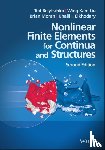Stel een vraag
Ik heb een vraag over het boek:
‘Nonlinear Finite Elements for Continua and Structures - Belytschko, Ted (Northwestern University, Liu, Wing Kam (Northwestern University, Moran, Brian (King Abdullah University of Science and Technology, Elkhodary, Khalil (The American University in Cairo’.
Vul het onderstaande formulier in.
We zullen zo spoedig mogelijk antwoorden.


